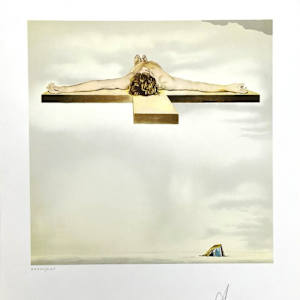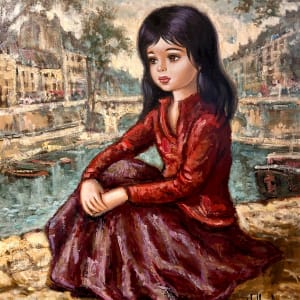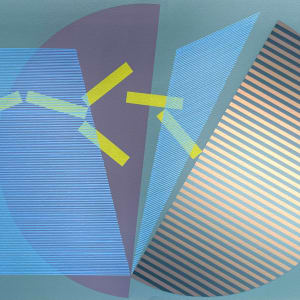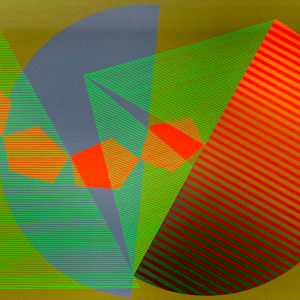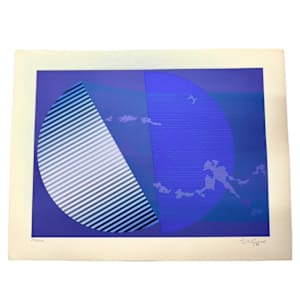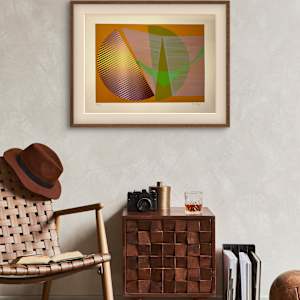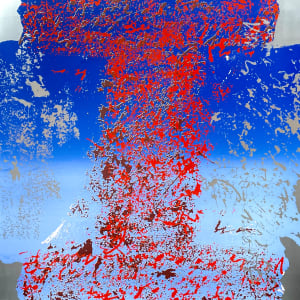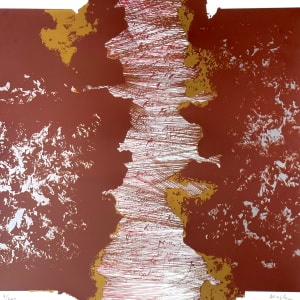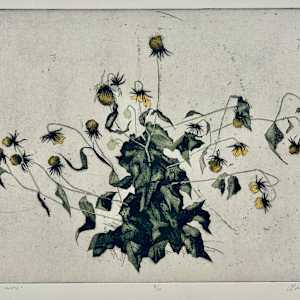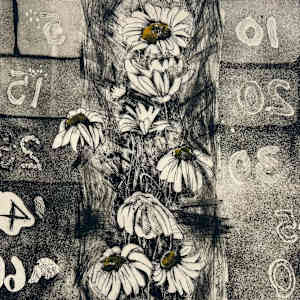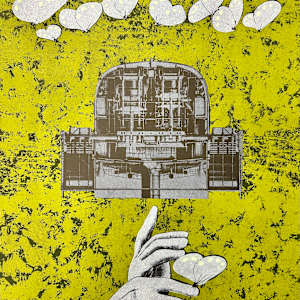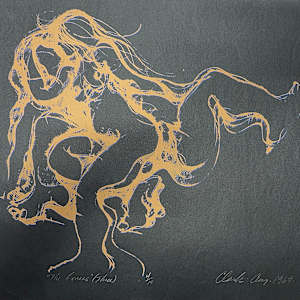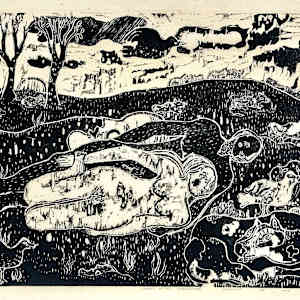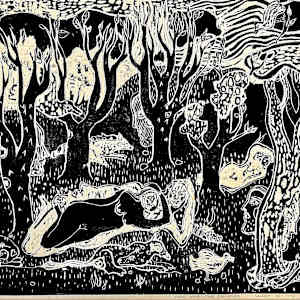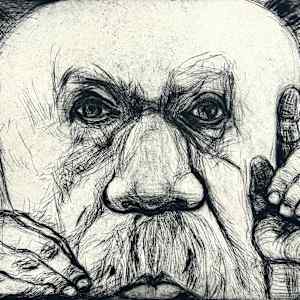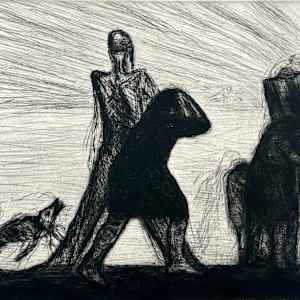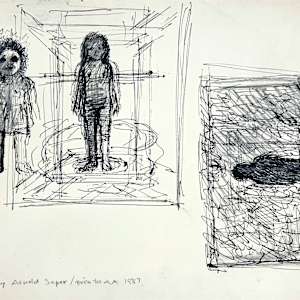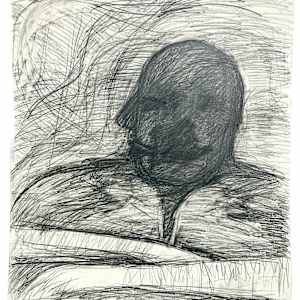William Perehudoff (1918-2013)
William Perehudoff (1918–2013) was a Canadian artist known for his association with colour field painting. Born in Saskatoon, Saskatchewan, he studied art with French artist Jean Chariot and at the Ozenfant School of Fine Arts in New York. His work was heavily influenced by Post-painterly Abstraction after meeting art critic Clement Greenberg in 1962. Perehudoff’s abstract works are housed in prominent collections, including the National Gallery of Canada, Remai Modern, and the Art Gallery of Ontario. Awarded the Saskatchewan Order of Merit (1994) and inducted into the Order of Canada (1999), he also became a member of the Royal Canadian Academy of Arts. He ceased painting due to failing eyesight in the early 2000s. His iconic murals from 1950 were preserved in 2009 and are now displayed at Remai Modern.
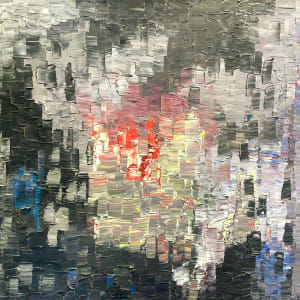
Sarah Margret Robertson (1891-1948)
Sarah Margaret Armour Robertson (1891–1948) was a Canadian painter known for her landscapes, still lifes, portraits, and murals. Born in Montreal, she studied at the Art Association of Montreal under William Brymner and Maurice Cullen, later training with Randolph Hewton.
A member of the Beaver Hall Group and a founding member of the Canadian Group of Painters, Robertson was influenced by both French modernism and the Group of Seven. She exhibited widely, including at the National Gallery of Canada, the Yale University Art Gallery, and internationally. Her later work featured bolder colors and expressive compositions, reflecting her deep appreciation for nature.
Robertson's paintings are held in major collections, including the National Gallery of Canada, the Montreal Museum of Fine Arts, and the Art Gallery of Ontario.
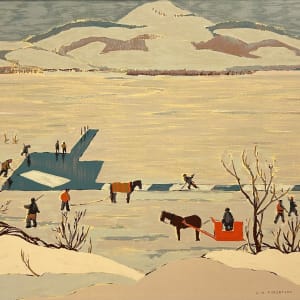
Sydney Berne
Sydney Berne (1921–2013) was a Canadian artist known for his expressive landscapes, seascapes, and urban scenes of Montreal and Toronto. Born in Toronto, he studied watercolors and sculpture at Central Technical School before serving overseas with the Canadian Army, where he continued his artistic studies with John Carlson.
Following the war, Berne studied abstract expressionism in Paris under André Paul, which influenced the freedom and vibrancy in his work. Settling in Montreal in 1946, he gained recognition through solo exhibitions in Toronto, Montreal, New York, and beyond, with his work featured in group shows across Canada and the U.S.
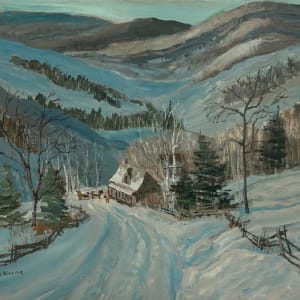
Joseph E Sampson (1887-1946)
Joseph Ernest Sampson was a British-Canadian artist, designer, and printer, best known for co-founding Sampson-Matthews Ltd. in 1918, a firm renowned for its silkscreen reproductions of Canadian art. Born in Liverpool, he studied at the Liverpool Academy of Art, the Julian Academy in Paris, and other European institutions before moving to Toronto in 1913.
Sampson was an influential figure in Canadian art, serving as president of the Arts and Letters Club (1938–1940) and co-founding the Canadian Society of Painters in Water Colour. His work is held in major collections, including the Art Gallery of Ontario and the Canadian War Art Collection. His legacy endures through the widely collected Sampson-Matthews silkscreens, which promoted Canadian art from 1941 to 1963.
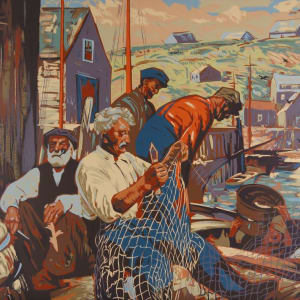
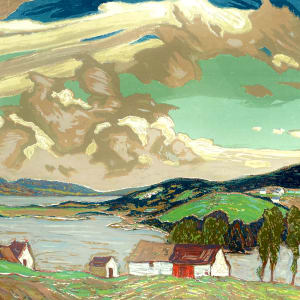
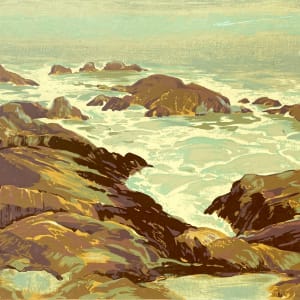
David Milne (1882-1953)
David Milne (1882–1953) was a distinguished Canadian painter, printmaker, and writer, known for his minimalist approach to landscape and still-life subjects. Born in Paisley, Ontario, Milne studied art in New York, where he was influenced by European and American modernist movements, including Impressionism and Fauvism. His career saw early successes with exhibitions at the Armory Show and the Panama-Pacific Exposition, but he is perhaps best known for his unique artistic style, characterized by simplicity and stark beauty.
Milne’s work, particularly in oil and watercolour, often depicted ordinary subjects, imbuing them with quiet dignity and a sense of stillness. His use of black and white, as well as his experimental colour drypoint prints, set him apart from his contemporaries. Though initially overshadowed by the Group of Seven, Milne gained recognition in the later years of his career, with exhibitions in major galleries and a retrospective after his death. His legacy as a master of minimalism endures, with his works held in prominent collections, including the National Gallery of Canada.
Milne’s exploration of both visual austerity and personal allegory, particularly in his later works, solidified his place as one of Canada's most significant artists.
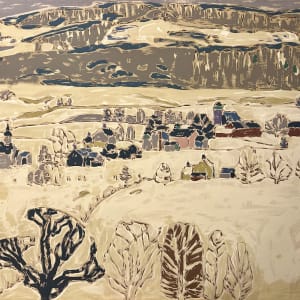
Clarence Tillenious (1913-2012)
Clarence Tillenius (1913–2012) was a renowned Canadian nature artist, celebrated for his wildlife paintings and commitment to conservation. Born in Manitoba, he developed a passion for drawing animals from an early age. Despite losing his right arm in a 1936 accident, he continued to paint with his left hand, honing his skills under artist Alexander J. Musgrove. Tillenius traveled extensively across North America, observing wildlife in their natural habitats, which inspired his work. His art was featured in publications, museum dioramas, and commissions, including the "Monarchs of the Canadian Wild" series. A Fellow of the Explorer’s Club and the Royal Geographical Society, he received numerous accolades, including the Order of Canada. Tillenius’s work is housed in private and public collections worldwide, with a permanent heritage collection at Winnipeg’s Pavilion Gallery.
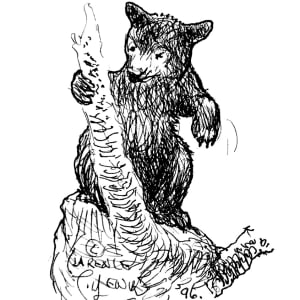
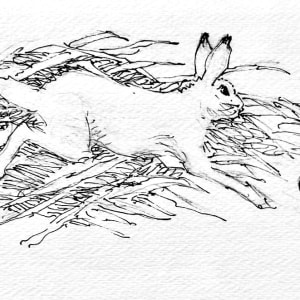
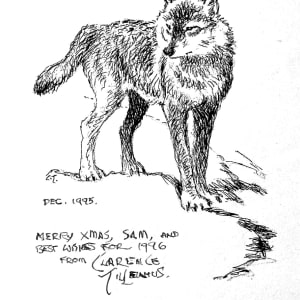
Robert Cenedella (1940-) American
Robert Cenedella (b. 1940) is an American painter known for his satirical and socially charged artworks. Trained at the Art Students League of New York under George Grosz, he later held the George Grosz Chair there from 1988 to 2016.
Rejecting abstract expressionism, Cenedella gained recognition for his bold critiques of consumerism, politics, and pop culture, including the controversial Santa Claus (1988) and the Hostility Dart Board (1968). His commissions include works for Bacardi, Absolut Vodka, and Le Cirque, and his retrospective exhibits have been shown internationally.
His life and career were the subject of the 2016 documentary Art Bastard, and his provocative paintings continue to challenge societal norms.
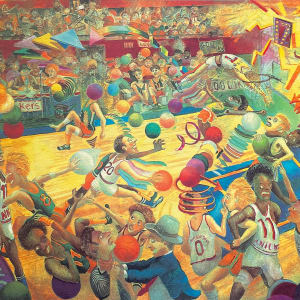
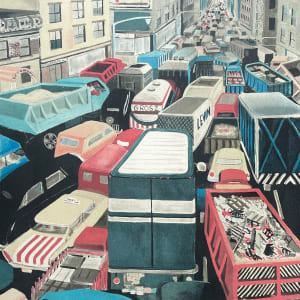
Horace Wickenden
Horace Watson “Wick” Wickenden (1901-1995) was an English-born Canadian artist and educator who immigrated to Saskatchewan in 1922. He earned his BA from the University of Saskatchewan in 1929 and studied art with notable instructors including Augustus Kenderdine, Nikola Bjelajac, and Eli Bornstein. Wickenden served in the Royal Canadian Air Force during World War II and furthered his art education in Calgary. A long-time teacher of English and art, he retired in 1964. Wickenden was active in the Saskatoon art community, serving as director and vice-president of the Saskatoon Art Centre. He exhibited widely in Saskatchewan and Ontario, with his work shown at the National Gallery of Canada in 1944. He passed away in 1995, and alongside his wife, artist Margaret Mary Robertson, he is commemorated by Wickenden Crescent in Saskatoon.
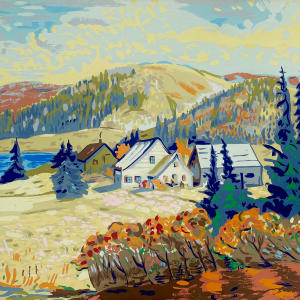
Leopoldo Torres Aguero (1924-1995) Argentia
Leopoldo Torres Aguero, born in Buenos Aires, was a key figure in the development of abstract art in Argentina. A member of the Movimiento de Arte Madi, Torres Aguero’s work evolved from early figurative painting to geometric abstraction in the 1960s, influenced by his travels to Paris and Japan. His art, often using mandalic and symbolic forms, reflects his exploration of spirituality and the Tao, merging the earth and sky through color and line. His works are held in major museums worldwide, including in Argentina, Cuba, and France, and he became an ambassador of Argentina to UNESCO. Torres Aguero’s distinctive approach integrates Zen Buddhism’s meditative qualities, focusing on the interplay of light, space, and the spirit.
Douglas Kakekagumick (1958-2009)
Douglas Kakegumick (born December 1958, Sandy Lake Reserve, North-Western Ontario) is an Oji-Cree artist known for his evocative acrylic paintings that explore the rich legends and stories of his culture. Inspired by the renowned artist Carl Ray, also from the Sandy Lake reserve, Kakegumick began painting in 1979, using his art to depict the deep spiritual and cultural heritage of the Oji-Cree people. His last name, "Kakekagumic," meaning "Everlasting Earth," reflects his connection to the land and traditions he portrays. Through his powerful and vibrant work, Kakegumick continues to share the timeless stories of his ancestors, creating a bridge between the past and the present.
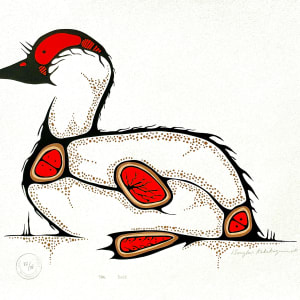
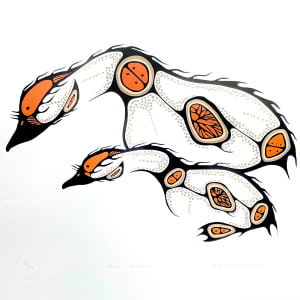
Lawrence Arthur Colley (LAC) Panton (1894-1954)
Lawrence Arthur Colley Panton, known professionally as L.A.C. Panton, was a Canadian painter and educator. Born in England, Panton emigrated to Canada at 17 and served in WWI before studying art at the Ontario College of Art. He became a prominent art teacher, eventually serving as the principal of the Ontario College of Art from 1951 to 1954.
Initially influenced by the Group of Seven, Panton’s style evolved into a synthesis of nature and abstraction. His work was exhibited internationally, including at the Tate Gallery, and is held in collections like the Art Gallery of Ontario and the National Gallery of Canada. Panton was a key figure in Canadian art organizations, including the Royal Canadian Academy of Arts and the Canadian Society of Painters in Water Colour.
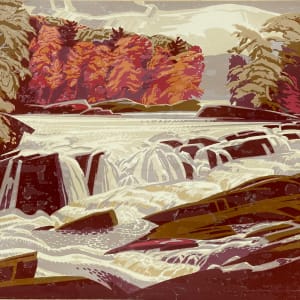
John Ensor (1905-1995)
John Ensor was a British-Canadian painter and industrial designer known for his wartime industrial scenes and Canadian landscapes. Born in Llanishen, Wales, he studied at the Accademia di Belle Arti di Firenze, the Polytechnic School of Art in London, and the Royal College of Art.
During World War II, he worked with the War Artists’ Advisory Committee, documenting aircraft production, troop training, and industrial sites. After moving to Canada in 1947, he founded the Ensor Industrial Design Association and became a member of the Royal Canadian Academy of Art. His painting Summer Stores was featured on a 1967 Canadian postage stamp.
Ensor created watercolors and sketches of the Royal Military College of Canada, now housed in the Canadian War Museum and Library and Archives Canada. His work is represented in major public collections across Canada.
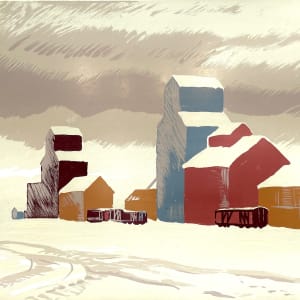
David (D.C.) Umholtz (1943-2014)
David Umholtz (1943–2014) was an American-born Canadian artist and printmaker, known for his work in lithography, serigraphy, and etching. Born in Harrisburg, Pennsylvania, he studied art education before moving to Canada in 1973. A passionate educator, he taught at several institutions including the University of Saskatchewan, Nova Scotia College of Art and Design, and Emily Carr College of Art and Design. In 1977, Umholtz founded Moosehead Press in Winnipeg, where he produced prints for himself and other prominent Canadian artists. He had solo exhibitions across Canada and the United States, and his works are held in major Canadian collections, including the Canada Council Art Bank and the Beaverbrook Art Gallery. Umholtz lived on Deer Island, New Brunswick, where he maintained a studio until his passing in 2014.
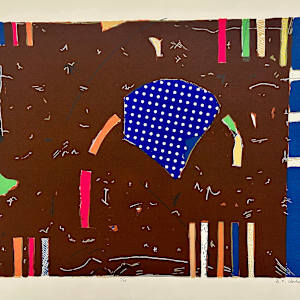
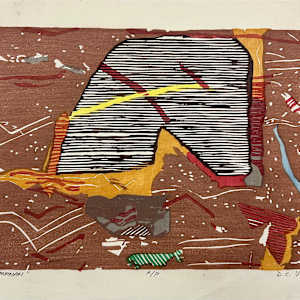
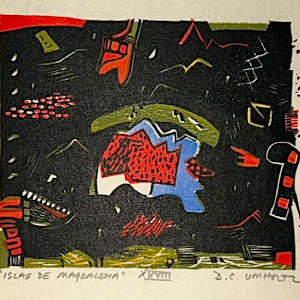
Kelly Clark (1935-1995)
Kelly Clark was a Winnipeg-based visual artist and musician known for his independent spirit and contributions to Canada’s art and music scenes. He studied at the University of Manitoba’s School of Art (1954–1958) and received a Canada Council grant to travel in England in 1960.
In the 1960s, Clark supported himself as a folk singer, releasing an album with Capitol Records. He also worked as graphics editor for Omphalos, Winnipeg’s underground newspaper, and as art director for Canadian Dimension magazine. Returning to painting in the mid-1970s, he remained committed to his artistic vision, refusing to exhibit at the Winnipeg Art Gallery on principle.
Though he never achieved mainstream success, Clark left a lasting impact on Winnipeg’s artistic community before his passing from cancer in 1995.
Sheila Butler (1938-)
Sheila Butler RCA (born 1938) is an American-Canadian visual artist, educator, and advocate known for her explorations of the human condition and the treatment of women. A founding member of Mentoring Artists for Women's Art (MAWA) in Winnipeg and the Sanavik Inuit Cooperative in Baker Lake, she has significantly contributed to the development of Canadian art communities.
Educated at Carnegie Mellon University, Butler moved to Canada in 1962 and worked extensively with Inuit artists in the Northwest Territories, fostering printmaking and craft initiatives. She later became a professor at the University of Manitoba, University of Winnipeg, and University of Western Ontario, influencing generations of artists until her retirement in 2004.
Her work—ranging from delicate drawings to bold paintings—addresses themes of violence, fear, and social issues, often inspired by media imagery. Acclaimed yet underrecognized, her art has been exhibited internationally, including in the National Gallery of Canada, the Winnipeg Art Gallery, and the Art Gallery of Hamilton.

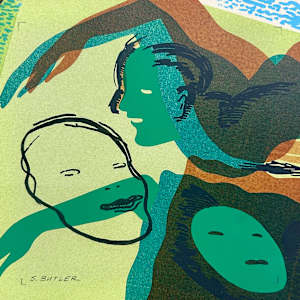
Arnold Saper (1933-2019)
Arnold Saper (1933–2019) was a Canadian artist and educator, known for his powerful portraits and significant influence on many artists. Born in Winnipeg, Saper grew up in the North End and later studied at the University of Manitoba, where he earned his Bachelor of Fine Arts in 1961 and an Education Certificate in 1963. His artistic journey took him to the State University of Iowa, where he studied under Mauricio Lasansky and earned a Master of Fine Arts degree in 1966.
Returning to Canada, Saper became a senior professor at the University of Manitoba's School of Art, where he taught for the remainder of his career. His teaching shaped the careers of many prominent Canadian artists. Saper was known for his dedication to the emotional and psychological aspects of the human condition, particularly in his portraits. Though not interested in trends, his work left a lasting impression on the art community, both in Winnipeg and internationally. He continued to create art until his death in 2019, four days before his 86th birthday, following a battle with Idiopathic Pulmonary Fibrosis.
Salvador Dali (1904-1989)
Salvador Dalí (1904–1989) was a Spanish Surrealist painter, sculptor, filmmaker, and writer known for his eccentric persona and dreamlike imagery. Influenced by Cubism, Futurism, and Metaphysical Painting, he joined the Surrealist movement in 1929, gaining fame for his “hand-painted dream photographs” that featured melting clocks, burning giraffes, and ambiguous double images (e.g., The Persistence of Memory, 1931).
Expelled from Surrealism in the late 1930s, Dalí moved to the United States (1940–1948), where he embraced commercial success, before returning to Spain. His later works explored religious and sexual themes, often centered on his wife, Gala. Beyond painting, he contributed to film, designing sequences for Spellbound (1945), and wrote novels and autobiographies. Though his legacy is debated, Dalí remains one of the most recognizable figures in modern art, with museums dedicated to his work in Figueras, Spain, and St. Petersburg, Florida.

